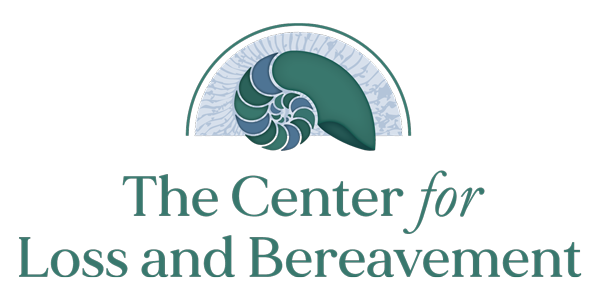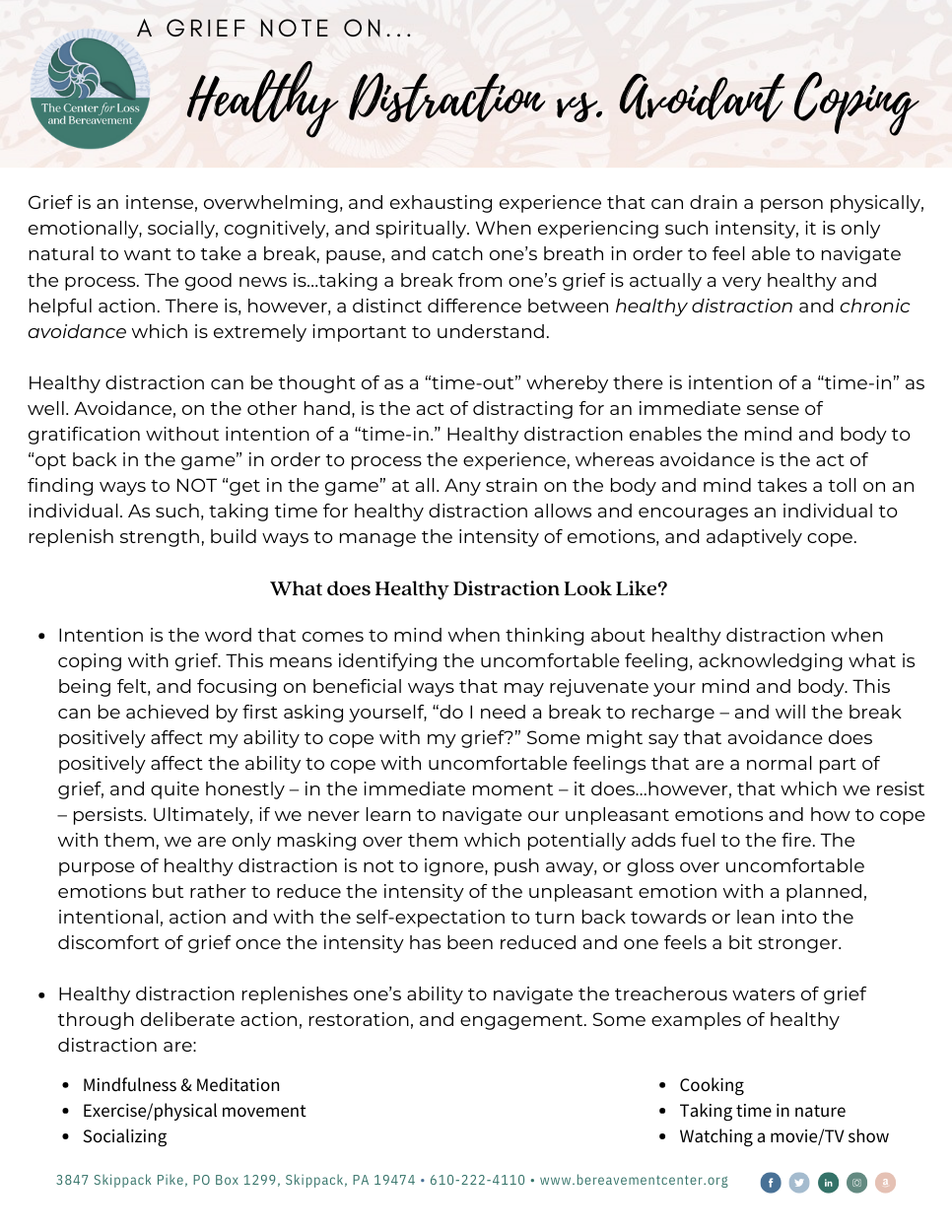CLB Grief Notes
A Grief Note On…
Healthy Distractions vs. Avoidant Coping
Grief is an intense, overwhelming, and exhausting experience that can drain a person physically, emotionally, socially, cognitively, and spiritually. When experiencing such intensity, it is only natural to want to take a break, pause, and catch one’s breath in order to feel able to navigate the process. The good news is…taking a break from one’s grief is actually a very healthy and helpful action. There is, however, a distinct difference between healthy distraction and chronic avoidance which is extremely important to understand.
Healthy distraction can be thought of as a “time-out” whereby there is intention of a “time-in” as well. Avoidance, on the other hand, is the act of distracting for an immediate sense of gratification without intention of a “time-in.” Healthy distraction enables the mind and body to “opt back in the game” in order to process the experience, whereas avoidance is the act of finding ways to NOT “get in the game” at all. Any strain on the body and mind takes a toll on an individual. As such, taking time for healthy distraction allows and encourages an individual to replenish strength, build ways to manage the intensity of emotions, and adaptively cope.
What does Healthy Distraction Look Like?
- Intention is the word that comes to mind when thinking about healthy distraction when coping with grief. This means identifying the uncomfortable feeling, acknowledging what is being felt, and focusing on beneficial ways that may rejuvenate your mind and body. This can be achieved by first asking yourself, “do I need a break to recharge – and will the break positively affect my ability to cope with my grief?” Some might say that avoidance does positively affect the ability to cope with uncomfortable feelings that are a normal part of grief, and quite honestly – in the immediate moment – it does…however, that which we resist – persists. Ultimately, if we never learn to navigate our unpleasant emotions and how to cope with them, we are only masking over them which potentially adds fuel to the fire. The purpose of healthy distraction is not to ignore, push away, or gloss over uncomfortable emotions but rather to reduce the intensity of the unpleasant emotion with a planned, intentional, action and with the self-expectation to turn back towards or lean into the discomfort of grief once the intensity has been reduced and one feels a bit stronger.
- Healthy distraction replenishes one’s ability to navigate the treacherous waters of grief through deliberate action, restoration, and engagement. Some examples of healthy distraction are:
- Mindfulness & Meditation
- Exercise/physical movement
- Socializing
- Learning/returning to a hobby
- Playing games/cards
- Listening to music
What Does Avoidant Coping Look Like?
- In contrast, coping through avoidance is the act of ignoring an unpleasant feeling or avoiding a stressful trigger in the hopes and belief that the discomfort will go away. This type of behavior can easily become a pattern because as mentioned previously, the solution of avoidance may lead to momentary comfort, which perpetuates a belief that if an unpleasant feeling or trigger is not acknowledged or experienced, then one does not feel pain or discomfort. The problem with avoidant coping is that it never lets you learn how to manage uncomfortable feelings. Behaviors associated with avoidant coping replace the processing of grief, which does not make the grief go away in the long-term but can potentially stunt a person in their grief journey resulting in exacerbation in underlying feelings of anger, anxiety, sadness, and guilt. Consequently, if unpleasant feelings – such as those associated with grief are not experienced, one cannot build resilience, perpetuating a belief that one is incapable of sitting with discomfort.
- Avoidance is a short-term solution with long-term consequences because grief does not simply vanish when we do not acknowledge it or allow ourselves to experience the feelings that come along with it. Some examples of avoidance include:
- Steering clear of people who may bring up the person who died
- Focusing energy on caring for others such as children/family
- Turning to substances to numb feelings
- Avoiding favorite places that remind you of the person who died
- Media overuse such as excessive social media, or TV/movies
- Overworking
- Overeating
- Shopping or excessive spending
- Traveling to “escape” feelings
- Changing subject away from loss
Balance
The key to navigating the grieving process is to find a balance whereby an individual can consciously lean into and experience the feelings that grief brings, rather than struggle against the discomfort, and lean out of the intensity of the experience. Imagine a pendulum that swings from one side to the other. Once activated, the pendulum continuously swings in and out. It does not get stuck on one side or the other. Swinging into grief may be where you allow the deep emotion to be experienced through crying, yelling, and feeling the loss. But, just as the pendulum swings out, you too can swing out and take time for some healthy distraction – allowing yourself to build up the strength needed to swing back into the grief. This can be thought of as “dosing” your grief – which is finding time to experience your feelings while also finding time to take a break from them.
Join Our
Mailing List
Donate
Today
Request
Information

Affiliations
• NACG
• CBEM Changemaker
• ADEC
• Charity Navigator
Quick Links
About Us
Individual & Family Grief Counseling
Volunteer
News
Grief Support Resources
Contact
Ph: 610-222-4110
Fax: 610-222-4116
3847 Skippack Pike
P.O. Box 1299
Skippack, PA 19474
Support The Center For
Loss and Bereavement
